Unit 5 Learning from nature 教材习题精讲课件(共29张)高二英语外研版(2019)选择性必修第三册
文档属性
| 名称 | Unit 5 Learning from nature 教材习题精讲课件(共29张)高二英语外研版(2019)选择性必修第三册 | 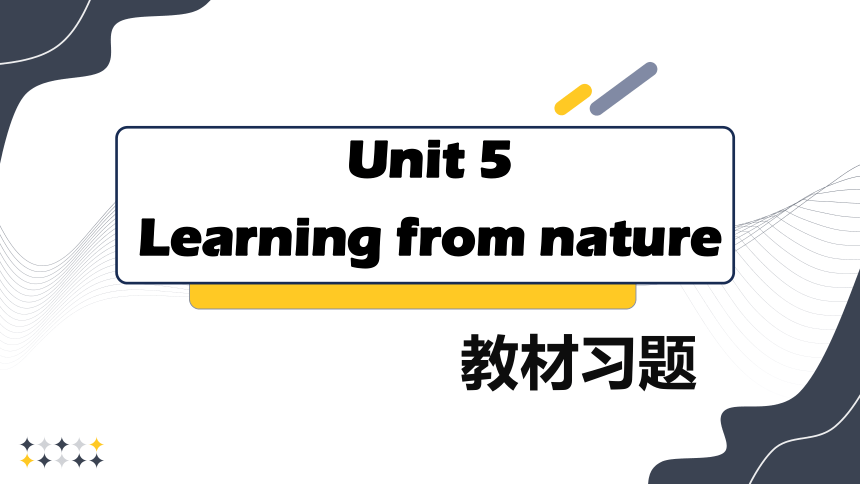 | |
| 格式 | pptx | ||
| 文件大小 | 4.0MB | ||
| 资源类型 | 教案 | ||
| 版本资源 | 外研版(2019) | ||
| 科目 | 英语 | ||
| 更新时间 | 2025-04-02 21:54:09 | ||
图片预览

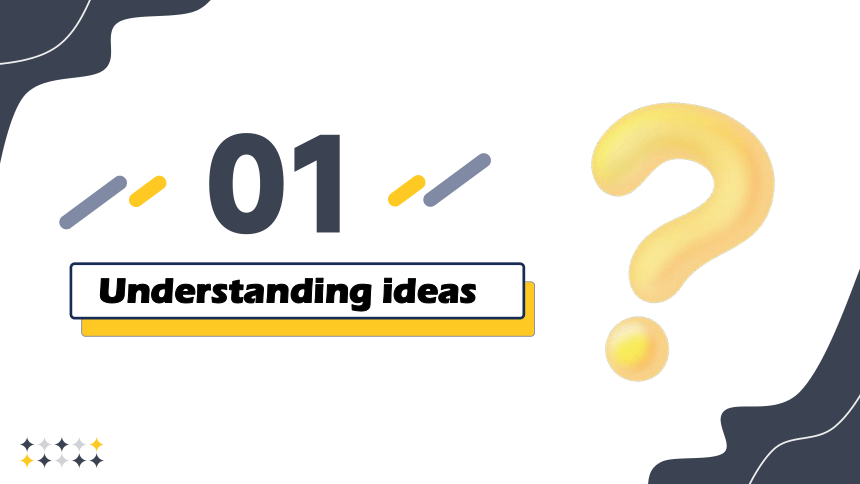
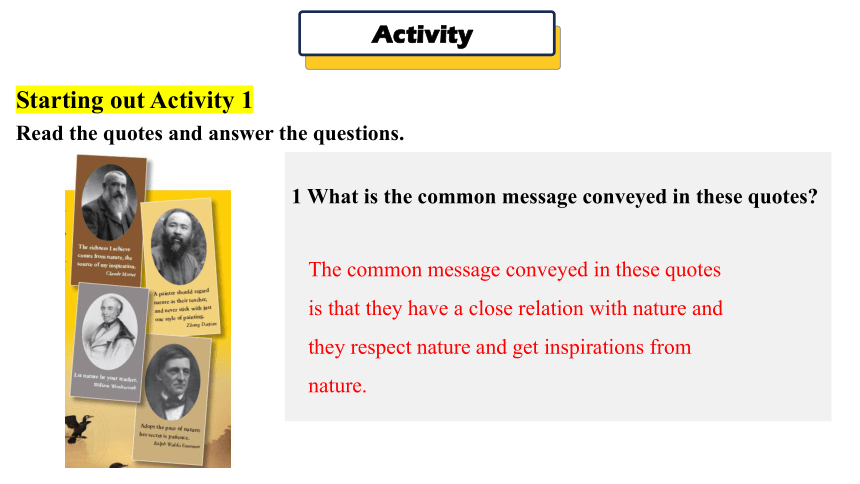
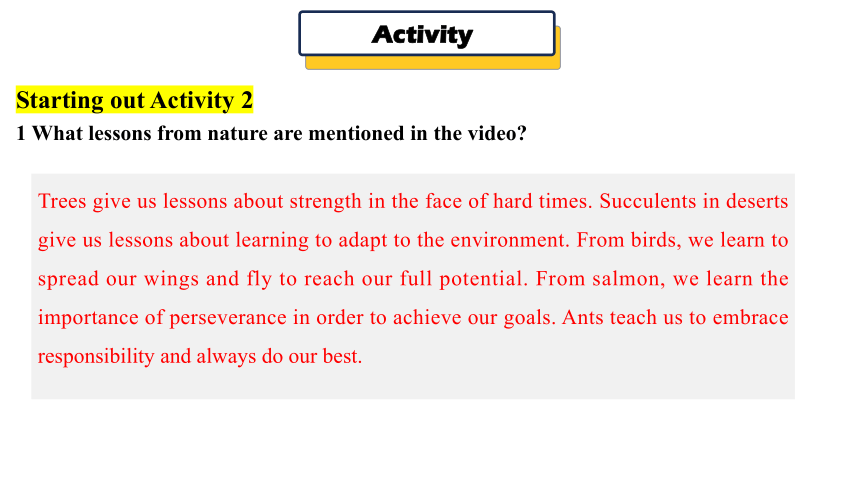

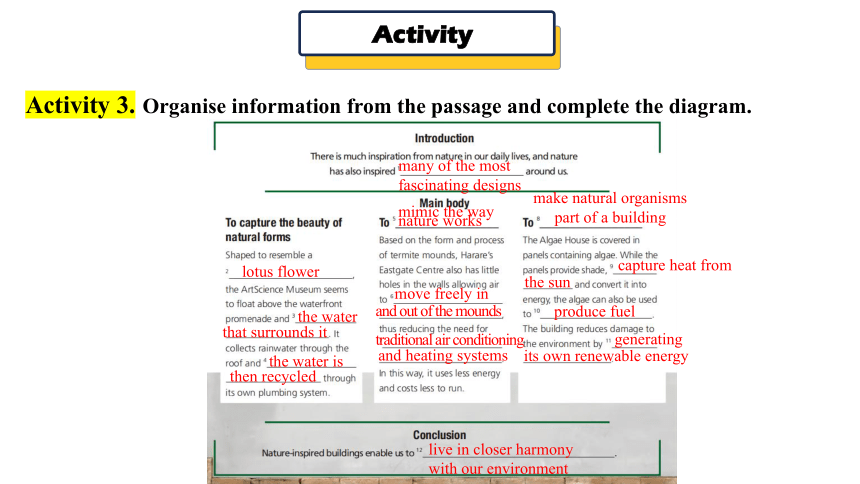

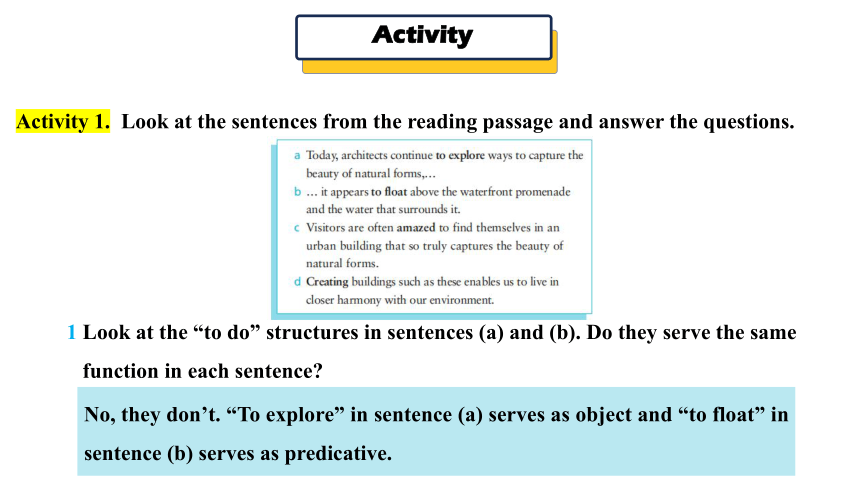

文档简介
(共29张PPT)
教材习题
Unit 5
Learning from nature
01
Understanding ideas
Starting out Activity 1
Read the quotes and answer the questions.
Activity
1 What is the common message conveyed in these quotes
The common message conveyed in these quotes
is that they have a close relation with nature and
they respect nature and get inspirations from
nature.
Starting out Activity 2
1 What lessons from nature are mentioned in the video
Activity
Trees give us lessons about strength in the face of hard times. Succulents in deserts give us lessons about learning to adapt to the environment. From birds, we learn to spread our wings and fly to reach our full potential. From salmon, we learn the importance of perseverance in order to achieve our goals. Ants teach us to embrace responsibility and always do our best.
Understanding ideas Activity 1.
Look at the photos and answer the questions.
Activity
A lotus flower, a termite mound and algae are shown in the pictures.
1 What is shown in the pictures How much do you know about them
Activity 2 Choose the magazine in which you would most likely find the passage. Give your reasons.
1 Extraordinary Architects
2 Living on earth
3 Architecture Frontier
4 Natural World
√
Activity 3. Organise information from the passage and complete the diagram.
Activity
many of the most
fascinating designs
lotus flower
that surrounds it
the water is
mimic the way
nature works
move freely in
traditional air conditioning
make natural organisms part of a building
the sun
produce fuel
its own renewable energy
the water
then recycled
and out of the mounds
and heating systems
capture heat from
generating
live in closer harmony with our environment
02
Using language
Activity 1. Look at the sentences from the reading passage and answer the questions.
Activity
1 Look at the “to do” structures in sentences (a) and (b). Do they serve the same
function in each sentence
No, they don’t. “To explore” in sentence (a) serves as object and “to float” in sentence (b) serves as predicative.
Activity 1. Look at the sentences from the reading passage and answer the questions.
Activity
2 In sentence (c), is the -ed form used as an adjective or a past participle Why
does the author use the -ed form other than the -ing form
·The -ed form is used as an adjective.
·The author wants to describe the visitors’ feeling, so the -ed form is used.
Activity 1. Look at the sentences from the reading passage and answer the questions.
Activity
3 What is the function of the -ing form in sentence (d)
·The -ing form is used as subject.
1 _________ (draw) inspiration from nature is a tradition that goes back centuries. Nowhere is this better illustrated than in the beautiful Lingering Garden of Suzhou. The main principle of its design is 2 ________________ (recreate) natural landscapes in miniature. First established in the Ming Dynasty, the original garden contained a rockery to symbolise Tiantai Mountain. Pine and bamboo groves were added later, along with a pond and an island. Visitors would be 3 _________ (astonish) to find the garden modeled closely on natural features. Visitors are also supposed 4 _________ (explore) it scene-by-scene. This could vary from a view of a pond and the splashing of fish, to a tree in blossom, a pagoda or a moon-shaped gate.
Activity 2. Complete the passage with the correct form of the verbs in brackets.
Activity
Drawing
to recreate/recreating
astonished
to explore
Activity 3. Read the information below and write a paragraph introducing the 24 Solar Terms with the words in the box. Use the structures you have learnt in this unit where appropriate.
Activity
Origin
created by farmers in Ancient China
based on Chinese lunar calendar
determined by the changes in the position of the sun
Significance
changes in weather mean a lot to farmers
determine the best time to sow and harvest
wisdom learnt from nature
First term
Beginning of Spring
days become longer and the temperature increases
Cultural heritage
added to UNESCO’s List of Intangible Cultural Heritage in 2016
learn determine show amaze use
Activity 3. Read the information below and write a paragraph introducing the 24 Solar Terms with the words in the box. Use the structures you have learnt in this unit where appropriate.
Activity
Learning from nature’s wisdom led farmers in Ancient China to create the 24 Solar Terms, which were based on observation of changes of seasons, astronomy and other natural phenomena. Indicating changes in weather conditions, the 24 Solar Terms remain of particular importance to farmers for guiding their practices. The first term is known as “Beginning of Spring”, and marks when days become longer and the temperature begins to increase. Nowadays, the 24 Solar Terms not only apply to farming, but also guide Chinese people in everyday life. So varied are the functions of the Solar Terms and their contributions to cultural identity, that in 2016, they were added to UNESCO’s List of Intangible Cultural Heritage.
Activity 5. Read the passage about biomimicry and answer the questions. Pay attention to the words and expressions in bold.
Activity
When solving a design problem, you can sometimes look to nature for a solution. One of the early examples is the study of birds to enable human flight. The Wright brothers got their inspiration from observing pigeons in flight, and in 1903 successfully obtained a patent for their designs for the first aeroplane. This approach, called biomimicry, studies and imitates nature’s designs and processes to seek solutions to human problems. There are many types of biomimicry, among which the most common one is copying form and shape. By imitating the beak of a bird, for example, bullet trains can be made to run much faster and more quietly. Another type of biomimicry is taking inspiration from the abilities of animals. Inspired by dolphins, people have learnt how to send signals underwater, which is currently employed in tsunami early-warning systems.
Activity 5. Read the passage about biomimicry and answer the questions. Pay attention to the words and expressions in bold.
Activity
1 What are the types of biomimicry mentioned in the passage What else do you know about them
2 What other examples of biomimicry can you think of Share them with the class.
One is copying form and shape. Another one is taking inspiration from the abilities of animals.
Activity 6. Complete the information with the words and expressions in activity 5.
Activity
taking inspiration from
Copying
observing
inspired by
seeking solutions to
Activity 8. Read the passage and answer the questions.
Activity
One of the outstanding features of traditional Chinese martial arts is the way they imitate animal movements. This came about because many Chinese martial artists admired the natural instincts, senses and fighting abilities that animals possess in order to survive in the wild. The first set of animal-imitating exercises came into being about 2,000 years ago. It was called Wu Qin Xi, or Five-animal Exercises, created by Hua Tuo (ca145–208). As a physician during the Han Dynasty, Hua Tuo is often credited with being the first in China to use anesthesia during surgery. He was known as the best physician of his time, and was an expert in acupuncture.
Activity 8. Read the passage and answer the questions.
Activity
1 Why were Chinese martial artists inspired by animal movements
2 What were Hua Tuo’s achievements
【Answer: Because many Chinese martial artists admired the natural instincts, senses and fighting abilities that animals possess in order to survive in the wild.】
【Answer: Hua Tuo created Wu Qin Xi. He was the first physician to use anesthesia during surgery in China. He was known as the best physician of his time and he was an expert in acupuncture.】
Activity 9. Listen to the conversation about Wu Qin Xi and tick the topics mentioned by the speakers.
Activity
The creator of Wu Qin Xi
Who can practise the exercises
Why these animals were chosen
Physical benefits
Mental benefits
How to teach the exercises
Activity 10. Listen again and complete the introduction to Wu Qin Xi.
Activity
Wu Qin Xi was created by Hua Tuo almost 2,000 years ago. It means “Five-animal Exercises”, and each animal is 1 ___________________________. By doing these exercises, people learn from these animals and help 2 ___________________________. For example, the tiger exercise 3 ____________ the liver. The bear exercise helps people with good digestion. The monkey exercise helps 4 ___________________; the 5 ___________ is good for the kidney; and the crane exercise is 6 _______________. Some people believe Wu Qin Xi helps them 7 _____________________. Some of the Wu Qin Xi masters lived to 8 _______________________, and still had good eyesight, hearing and strong teeth. Wu Qin Xi has 9 _____________, too. It can help 10 _________________________________.
identified with a form of exercise
the / their organs to work better
does good to
the heart to work well
deer exercise
good for the lung
to live to an advanced age
mental benefits
to relax the mind and improve concentration
more than 90 years of age
Activity 11. Complete the boxes with the expressions from the conversation.
Activity
By…, you learn…
Really
It helps people to…
... is good for...
Talking about benefits
Showing interest
That’s interesting!
That’s very impressive.
Sounds great!
By..., you learn...
It helps people to...
...is good for...
Really
That’s interesting!
That’s very impressive.
Sounds great!
03
Developing ideas
Activity 2. Read the passage and find out what Tao and Thoreau learnt from nature.
Activity
Both of them got inspiration from nature for their literary works. Both of them lived simply in nature with few material desires, which helped them to attain their personal fulfilment.
Activity 3. Organise information from the passage and complete the chart.
Activity
· He went back to nature
because he felt conflicted over
life at court.
· His return to nature was a
reaction to a lifestyle he was
opposed to.
· The calm and peaceful life he
wrote about is in contrast to
and critical of the depressive
court life.
· Thoreau’s return to nature was a
personal decision to transform
the way he lived.
· Thoreau’s descriptions of nature
emphasised the beauty and purity
of the wild areas around him.
· He wrote about nature in order to
convince people that animals and
plants had a right to live and
prosper, as we do.
· Both made dramatic
transformations to their
lives in order to reconnect
with nature.
· Both were happy to
withdraw from
contemporary life, seeking
a harmonious relationship
with nature in the quietness
of their lives.
Think & share
1 Why did it take Tao and Thoreau great courage to walk away from their previous lives
2 Why are their ideas important to our lives today
Because it was difficult to reject the easy and familiar life they used to live.
Because in today’s modern world, we still need to live harmoniously with nature, and live a simple life. Fewer material desires lead to better personal well-being and fulfilment.
4 Compare the two reading passages in this unit. In what ways does each passage contribute to the unit theme
Both passages have the common theme of learning from nature. The first passage focuses on the inspirations people get from nature, while the second focuses more on the natural way of living that people still need today. The second passage calls upon us to live in harmony with nature, which is an important message for today.
Activity 4. Work in pare the quotes by Tao and Thoreau.
Activity
Beyond the dark and distance lies a village,
The smoke above reluctant to depart.
A dog is barking somewhere down the lane,
And chickens sit atop the mulberry tree.
Live in each season as it passes; breathe the
air, drink the drink, taste the fruit, and resign
yourself to the influences of each. Let them be your only diet, drink and botanical medicines.
1 Find the Chinese version of Tao’s poem, and translate Thoreau’s quote into Chinese.
归园田居(其一)
陶渊明
少无适俗韵,性本爱丘山。误落尘网中,一去十三年。
羁鸟恋旧林,池鱼思故渊。开荒南野际,守拙归园田。
方宅十余亩,草屋八九间。榆柳荫后檐,桃李罗堂前。
暖暖远人村,依依墟里烟。狗吠深巷中,鸡鸣桑树颠。
户庭无尘杂,虚室有余闲。久在樊笼里,复得返自然。
好好度过每一个季节,呼吸新鲜的空气,
畅饮美酒,品尝水果
尽情享受这一切。
让生活中只有饮食和草药。
Activity 5. Read the story and answer the questions.
Activity
1 What does a butterfly do to get out of its pupa
2 Why did the man think he needed to help the butterfly
3 What happened to the butterfly after the man enlarged the hole in the pupa
4 What is the lesson behind this story What else can you learn from it
The butterfly struggles to force its body through the little hole.
Because the butterfly couldn’t get out. The struggle seemed too hard for its weak body.
The butterfly dragged itself around weakly, and then died.
We need struggle to grow strong and survive.
【Sample】
A Lesson from Ants
One day, I was resting in my grandparent’s garden when I saw that the sky was covered with dark clouds, this being a sure sign of rain. All of a sudden, an ant came into my sight. The tiny creature was trying hard to carry a tiny piece of bread to its nest, but its efforts were in vain. Each time the ant picked up the piece of bread, it rolled down its body and fell onto the ground. While I was wondering why the ant was trying so hard to achieve the impossible, it was joined by more ants. This group of ants worked together, and eventually they managed to carry the piece of bread to their nest.
Similarly, we can cooperate and collaborate in order to achieve what seems impossible for us to do as individuals. In order to achieve our goals, we should work together.
Activity
THANKS
教材习题
Unit 5
Learning from nature
01
Understanding ideas
Starting out Activity 1
Read the quotes and answer the questions.
Activity
1 What is the common message conveyed in these quotes
The common message conveyed in these quotes
is that they have a close relation with nature and
they respect nature and get inspirations from
nature.
Starting out Activity 2
1 What lessons from nature are mentioned in the video
Activity
Trees give us lessons about strength in the face of hard times. Succulents in deserts give us lessons about learning to adapt to the environment. From birds, we learn to spread our wings and fly to reach our full potential. From salmon, we learn the importance of perseverance in order to achieve our goals. Ants teach us to embrace responsibility and always do our best.
Understanding ideas Activity 1.
Look at the photos and answer the questions.
Activity
A lotus flower, a termite mound and algae are shown in the pictures.
1 What is shown in the pictures How much do you know about them
Activity 2 Choose the magazine in which you would most likely find the passage. Give your reasons.
1 Extraordinary Architects
2 Living on earth
3 Architecture Frontier
4 Natural World
√
Activity 3. Organise information from the passage and complete the diagram.
Activity
many of the most
fascinating designs
lotus flower
that surrounds it
the water is
mimic the way
nature works
move freely in
traditional air conditioning
make natural organisms part of a building
the sun
produce fuel
its own renewable energy
the water
then recycled
and out of the mounds
and heating systems
capture heat from
generating
live in closer harmony with our environment
02
Using language
Activity 1. Look at the sentences from the reading passage and answer the questions.
Activity
1 Look at the “to do” structures in sentences (a) and (b). Do they serve the same
function in each sentence
No, they don’t. “To explore” in sentence (a) serves as object and “to float” in sentence (b) serves as predicative.
Activity 1. Look at the sentences from the reading passage and answer the questions.
Activity
2 In sentence (c), is the -ed form used as an adjective or a past participle Why
does the author use the -ed form other than the -ing form
·The -ed form is used as an adjective.
·The author wants to describe the visitors’ feeling, so the -ed form is used.
Activity 1. Look at the sentences from the reading passage and answer the questions.
Activity
3 What is the function of the -ing form in sentence (d)
·The -ing form is used as subject.
1 _________ (draw) inspiration from nature is a tradition that goes back centuries. Nowhere is this better illustrated than in the beautiful Lingering Garden of Suzhou. The main principle of its design is 2 ________________ (recreate) natural landscapes in miniature. First established in the Ming Dynasty, the original garden contained a rockery to symbolise Tiantai Mountain. Pine and bamboo groves were added later, along with a pond and an island. Visitors would be 3 _________ (astonish) to find the garden modeled closely on natural features. Visitors are also supposed 4 _________ (explore) it scene-by-scene. This could vary from a view of a pond and the splashing of fish, to a tree in blossom, a pagoda or a moon-shaped gate.
Activity 2. Complete the passage with the correct form of the verbs in brackets.
Activity
Drawing
to recreate/recreating
astonished
to explore
Activity 3. Read the information below and write a paragraph introducing the 24 Solar Terms with the words in the box. Use the structures you have learnt in this unit where appropriate.
Activity
Origin
created by farmers in Ancient China
based on Chinese lunar calendar
determined by the changes in the position of the sun
Significance
changes in weather mean a lot to farmers
determine the best time to sow and harvest
wisdom learnt from nature
First term
Beginning of Spring
days become longer and the temperature increases
Cultural heritage
added to UNESCO’s List of Intangible Cultural Heritage in 2016
learn determine show amaze use
Activity 3. Read the information below and write a paragraph introducing the 24 Solar Terms with the words in the box. Use the structures you have learnt in this unit where appropriate.
Activity
Learning from nature’s wisdom led farmers in Ancient China to create the 24 Solar Terms, which were based on observation of changes of seasons, astronomy and other natural phenomena. Indicating changes in weather conditions, the 24 Solar Terms remain of particular importance to farmers for guiding their practices. The first term is known as “Beginning of Spring”, and marks when days become longer and the temperature begins to increase. Nowadays, the 24 Solar Terms not only apply to farming, but also guide Chinese people in everyday life. So varied are the functions of the Solar Terms and their contributions to cultural identity, that in 2016, they were added to UNESCO’s List of Intangible Cultural Heritage.
Activity 5. Read the passage about biomimicry and answer the questions. Pay attention to the words and expressions in bold.
Activity
When solving a design problem, you can sometimes look to nature for a solution. One of the early examples is the study of birds to enable human flight. The Wright brothers got their inspiration from observing pigeons in flight, and in 1903 successfully obtained a patent for their designs for the first aeroplane. This approach, called biomimicry, studies and imitates nature’s designs and processes to seek solutions to human problems. There are many types of biomimicry, among which the most common one is copying form and shape. By imitating the beak of a bird, for example, bullet trains can be made to run much faster and more quietly. Another type of biomimicry is taking inspiration from the abilities of animals. Inspired by dolphins, people have learnt how to send signals underwater, which is currently employed in tsunami early-warning systems.
Activity 5. Read the passage about biomimicry and answer the questions. Pay attention to the words and expressions in bold.
Activity
1 What are the types of biomimicry mentioned in the passage What else do you know about them
2 What other examples of biomimicry can you think of Share them with the class.
One is copying form and shape. Another one is taking inspiration from the abilities of animals.
Activity 6. Complete the information with the words and expressions in activity 5.
Activity
taking inspiration from
Copying
observing
inspired by
seeking solutions to
Activity 8. Read the passage and answer the questions.
Activity
One of the outstanding features of traditional Chinese martial arts is the way they imitate animal movements. This came about because many Chinese martial artists admired the natural instincts, senses and fighting abilities that animals possess in order to survive in the wild. The first set of animal-imitating exercises came into being about 2,000 years ago. It was called Wu Qin Xi, or Five-animal Exercises, created by Hua Tuo (ca145–208). As a physician during the Han Dynasty, Hua Tuo is often credited with being the first in China to use anesthesia during surgery. He was known as the best physician of his time, and was an expert in acupuncture.
Activity 8. Read the passage and answer the questions.
Activity
1 Why were Chinese martial artists inspired by animal movements
2 What were Hua Tuo’s achievements
【Answer: Because many Chinese martial artists admired the natural instincts, senses and fighting abilities that animals possess in order to survive in the wild.】
【Answer: Hua Tuo created Wu Qin Xi. He was the first physician to use anesthesia during surgery in China. He was known as the best physician of his time and he was an expert in acupuncture.】
Activity 9. Listen to the conversation about Wu Qin Xi and tick the topics mentioned by the speakers.
Activity
The creator of Wu Qin Xi
Who can practise the exercises
Why these animals were chosen
Physical benefits
Mental benefits
How to teach the exercises
Activity 10. Listen again and complete the introduction to Wu Qin Xi.
Activity
Wu Qin Xi was created by Hua Tuo almost 2,000 years ago. It means “Five-animal Exercises”, and each animal is 1 ___________________________. By doing these exercises, people learn from these animals and help 2 ___________________________. For example, the tiger exercise 3 ____________ the liver. The bear exercise helps people with good digestion. The monkey exercise helps 4 ___________________; the 5 ___________ is good for the kidney; and the crane exercise is 6 _______________. Some people believe Wu Qin Xi helps them 7 _____________________. Some of the Wu Qin Xi masters lived to 8 _______________________, and still had good eyesight, hearing and strong teeth. Wu Qin Xi has 9 _____________, too. It can help 10 _________________________________.
identified with a form of exercise
the / their organs to work better
does good to
the heart to work well
deer exercise
good for the lung
to live to an advanced age
mental benefits
to relax the mind and improve concentration
more than 90 years of age
Activity 11. Complete the boxes with the expressions from the conversation.
Activity
By…, you learn…
Really
It helps people to…
... is good for...
Talking about benefits
Showing interest
That’s interesting!
That’s very impressive.
Sounds great!
By..., you learn...
It helps people to...
...is good for...
Really
That’s interesting!
That’s very impressive.
Sounds great!
03
Developing ideas
Activity 2. Read the passage and find out what Tao and Thoreau learnt from nature.
Activity
Both of them got inspiration from nature for their literary works. Both of them lived simply in nature with few material desires, which helped them to attain their personal fulfilment.
Activity 3. Organise information from the passage and complete the chart.
Activity
· He went back to nature
because he felt conflicted over
life at court.
· His return to nature was a
reaction to a lifestyle he was
opposed to.
· The calm and peaceful life he
wrote about is in contrast to
and critical of the depressive
court life.
· Thoreau’s return to nature was a
personal decision to transform
the way he lived.
· Thoreau’s descriptions of nature
emphasised the beauty and purity
of the wild areas around him.
· He wrote about nature in order to
convince people that animals and
plants had a right to live and
prosper, as we do.
· Both made dramatic
transformations to their
lives in order to reconnect
with nature.
· Both were happy to
withdraw from
contemporary life, seeking
a harmonious relationship
with nature in the quietness
of their lives.
Think & share
1 Why did it take Tao and Thoreau great courage to walk away from their previous lives
2 Why are their ideas important to our lives today
Because it was difficult to reject the easy and familiar life they used to live.
Because in today’s modern world, we still need to live harmoniously with nature, and live a simple life. Fewer material desires lead to better personal well-being and fulfilment.
4 Compare the two reading passages in this unit. In what ways does each passage contribute to the unit theme
Both passages have the common theme of learning from nature. The first passage focuses on the inspirations people get from nature, while the second focuses more on the natural way of living that people still need today. The second passage calls upon us to live in harmony with nature, which is an important message for today.
Activity 4. Work in pare the quotes by Tao and Thoreau.
Activity
Beyond the dark and distance lies a village,
The smoke above reluctant to depart.
A dog is barking somewhere down the lane,
And chickens sit atop the mulberry tree.
Live in each season as it passes; breathe the
air, drink the drink, taste the fruit, and resign
yourself to the influences of each. Let them be your only diet, drink and botanical medicines.
1 Find the Chinese version of Tao’s poem, and translate Thoreau’s quote into Chinese.
归园田居(其一)
陶渊明
少无适俗韵,性本爱丘山。误落尘网中,一去十三年。
羁鸟恋旧林,池鱼思故渊。开荒南野际,守拙归园田。
方宅十余亩,草屋八九间。榆柳荫后檐,桃李罗堂前。
暖暖远人村,依依墟里烟。狗吠深巷中,鸡鸣桑树颠。
户庭无尘杂,虚室有余闲。久在樊笼里,复得返自然。
好好度过每一个季节,呼吸新鲜的空气,
畅饮美酒,品尝水果
尽情享受这一切。
让生活中只有饮食和草药。
Activity 5. Read the story and answer the questions.
Activity
1 What does a butterfly do to get out of its pupa
2 Why did the man think he needed to help the butterfly
3 What happened to the butterfly after the man enlarged the hole in the pupa
4 What is the lesson behind this story What else can you learn from it
The butterfly struggles to force its body through the little hole.
Because the butterfly couldn’t get out. The struggle seemed too hard for its weak body.
The butterfly dragged itself around weakly, and then died.
We need struggle to grow strong and survive.
【Sample】
A Lesson from Ants
One day, I was resting in my grandparent’s garden when I saw that the sky was covered with dark clouds, this being a sure sign of rain. All of a sudden, an ant came into my sight. The tiny creature was trying hard to carry a tiny piece of bread to its nest, but its efforts were in vain. Each time the ant picked up the piece of bread, it rolled down its body and fell onto the ground. While I was wondering why the ant was trying so hard to achieve the impossible, it was joined by more ants. This group of ants worked together, and eventually they managed to carry the piece of bread to their nest.
Similarly, we can cooperate and collaborate in order to achieve what seems impossible for us to do as individuals. In order to achieve our goals, we should work together.
Activity
THANKS
